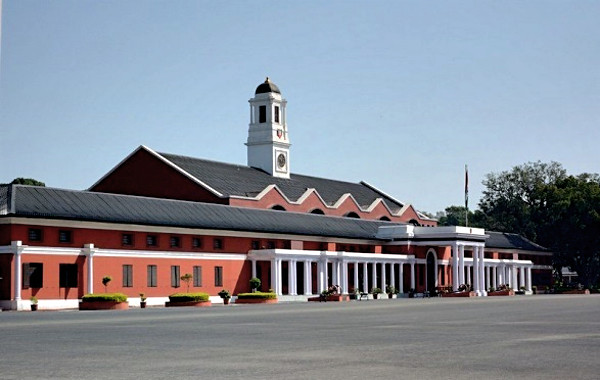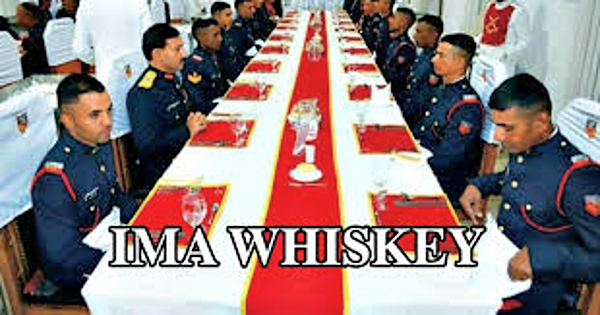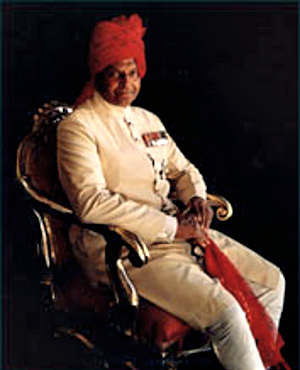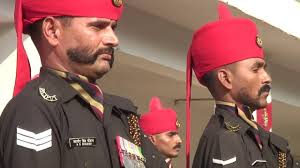Latest Contributions
Life in the Indian Military Academy (IMA), Dehradun

Born in a village in what is now Jharkhand, Sunil Kumar Choudhury did his graduation and post-graduation from Ranchi University. He joined the Indian Army in 1964 and was commissioned with the Rajput Regiment. He was assigned to 15 Rajput in 1965. He also qualified as a Commando from Infantry School, Mhow. After being released from the army in 1970, he served in the Central Reserve Police Force (CRPF) in West Bengal.
Sunil joined the Indian Revenue Service in 1971. He married his batch mate, Komala Raghavan, in 1975. After retirement on superannuation in 2002, he along with his wife Komala settled down in Bengaluru. Komala passed away in January 2018.
As I mentioned in my first story I felt the impact of 1962 Sino-Indian conflict and it changed my life in a big way. Serving with the armed forces of the country was never in my mind but the events of Oct-Nov 1962 pushed me towards taking steps to join the Indian Army.
One chilly early morning, a bunch of us looking not sure of ourselves arrived at the Dehradun Railway station. We received a warm reception by a team of uniformed men waiting to ferry us to the Academy located at the foothills of the Himalayas.
It was a royal treat to be allotted a fully furnished cabin with all the material comforts well beyond a university student’s imagination. And to top it all, we were also provided with the services of a trained civilian orderly to take care of our daily needs.
Over a period of time these orderlies become inseparable part of a cadet’s life during the entire training period developing mutual respect and affection.
The one attached to me was visibly delighted when I told him the very first day not to wake me to serve the customary bed tea and biscuit. Instead, he should feel free to have them himself. This was by no means a generous gesture on my part, but meant only to provide me with an additional fifteen minutes or so of precious sleep.
Soon, we found ourselves acquiring a new identity as ‘GC‘ (Gentleman Cadet) with changed appearances,thanks to Academy barbers ruthlessly using their pair of scissors on our black and thick unruly hair.
We were called GC as the academy expected its cadets to uphold the highest moral and ethical values. Inscribed in the oak panelling at the Eastern entrance of the iconic Chetwode Hall – a magnificent structure, is the Academy’s credo excerpted from the speech of Field Marshal Chetwode at the inauguration of the Academy in 1932.

Chetwode Hall at the Indian Military Academy (IMA), Dehradun.
Sam Manekshaw, who later went on to become the country’s first Indian Field Marshal, was one amongst the 40 cadets present on this occasion.

Field Marshal Sam Manekshaw (1914 – 2008) at the Indian Military Academy (IMA), Dehradun with Gentlemen Cadets.
Academy’s credo:
“The safety, honour and welfare of your country come first, always and every time.
The honour, welfare and comfort of the men you command come next.
Your own ease, comfort and safety come last, always and every time.”
In his inaugural address to us in the hallowed Chetwode Hall, Academy’s Commandant, Maj. General S. C. Pundit, a gallantry award winner, emphasised the significance of this credo in the army.
Even though the GCs came from the diverse backgrounds with different habits and social and economic backgrounds, we were assured that the academy aimed at plying a vital role in remoulding those differences and make the cadets into a homogenous group for the sake of instilling a common bonding, while at the same time, allowing us to retain our individual identity.
Soon we realised the Academy’s role as a melting pot of diverse culture. Unity amidst diversity was on full display in the campus. We were, however, forewarned about the most gruelling training schedules ahead aimed at nurturing our mental and physical potential with every GC being allowed equal space for growth within the given time frame. The pace of training at the academy was fast and gruelling. It becomes a test of one’s mettle and physical capabilities and in psychological terms a foretaste of what the trainees would encounter in the battlefield, where there is no room or scope for explaining or rationalising one’s failure.
The Commandant’s address was highly motivating instilling a sense of pride of being a part of this academy with a such a glorious past.
Transition from student’s life to that of a gentlemen cadet living in a highly regimented environment with extremely exacting routine was not too difficult, though at times annoying with certain archaic practices thrust upon us. Soon, I realised that the army, as an organisation, seemed loath to change. I moved as achieving my overriding concern was to successfully complete my training without getting distracted by trivia.

Gentlemen Cadets using bicycles to get around on the campus at the Indian Military Academy (IMA), Dehradun.
The day would start with a rigorous Physical Training session. at the end of the session we looked forward to wholesome breakfast in the GC’s mess with no restriction for the gluttons, as long as one scrupulously observed certain table manners including use of different kinds of forks and spoons as demonstrated at the beginning of the training. It was also a lesson that in the army, nothing is left to chance.
Being in the mess was a gastronomic delight. What followed thereafter during outdoor training, whether handling of weapons or negotiating obstacle course or climbing rugged mountains was more than adequate to burn all the extra calories one consumed.

Gentlemen Cadets in the mess at the Indian Military Academy (IMA), Dehradun.
As we moved on with the exacting training schedule, a very tragic incident took place within days of our joining the academy that even today it haunts me.
One evening, while on an outdoor exercise walking over the dry pebbled river bed of Tones river close to the academy with dark low clouds hanging over us accompanied by deafening sounds of thunder and blinding lightening, a GC from Chandigarh, Subhash Aluwalia, the only child of his parents was struck by lightning, killing him instantly.
I had a narrow escape as he was moving barely a few inches right behind me. Yet, our exercise was not called off. We were told that in a battle field one does not pause to mourn the dead. Our mental toughening had begun in earnest.
However, the next day, the academy was closed as a mark of respect to the departed soul who was cremated with full military honours in the presence of his inconsolable parents.
Soon enough life was back to the normal. From the campus during clear nights we could see the glittering Mussorie, but we were not allowed to go out of academy’s campus without first passing the drill test conducted by none other than Academy’s flamboyant Adjutant himself, then Maj. Bhawani Singh, son of the Maharaja Sawai Man Singh II of Jaipur. Most of us could clear only in our second attempt.

Maharaja Sawai Bhawani Singh Bahadur, MVC (1931 – 2011)
Major Bhawani Singh had endeared himself to all the GCs for his extremely charming demeanour. Once caught while returning after lights-off, I along with 3-4 GCs were marched into his office the following day for being awarded a suitable punishment for such horrific act of indiscipline.
When asked to explain the reason for our returning late, we sheepishly told him that we had gone to watch a Bengali movie of Satyajit Ray which got over late and in our anxiety to return on time, we even skipped our dinner at Quality Restaurant, a favourite haunt for the GCs.
Major Singh seemed convinced. We were reprimanded with these words “Don’t ever you repeat this! And if at all, you turn up late for whatever reason, see to it that you are not caught”. Thus our much dreaded “summary trial”, so to say, was over in next to no time. Needless to say, we got away lightly and never committed such “horrific act of indiscipline” again.
A little diversion here would perhaps be in order here. During the 1971 Indo-Pak war, the same Bhawani Singh, now Lt. Col., was tasked to carry out a deep penetration into West Pakistan. His inspired leadership and exemplary personal courage led to capture of large area of enemy territory forcing the enemy to retreat.
For this act of bravery, he was awarded the second highest gallantry award of Mahavir Chakra (MVC). By then, a probationer in Customs & Central Excise closely following the war as it progressed, I felt proud to be the one trained by this great soldier years back in the IMA.
But, what shocked me as to learn that during the infamous Emergency, he along with Rajmata Gayatri Devi Jaipur were detained under COFEPOSA on flimsy grounds under orders by a pliant Jt. Secretary COFEPOSA.
It was a case of an outright political vendetta by an oppressive government at the centre with an extra-constitutional authority calling the shots. The one issuing the detention order was later rewarded by elevating him out of turn as Member CBEC and the one who had shown the courage not to succumb to the pressure was stripped off his charge and had to wait for his promotion till the new political dispensation took charge in 1977.
Back to academy days. Despite having grown in a non-military environment, I could clear all tests, whether weapons, obstacle course, long marches with heavy loads, endurance tests, firings etc. with ease.
But it was with some trepidation when we were was asked to throw live High Explosive pineapple shaped hand grenades (36 HE) for the first time. Till then we had practiced throwing only dummy ones. These grenades were designed to disperse lethal fragments on detonation. Once the safety pin is pulled out and the safety lever freed, the grenade explodes in 4-5 seconds. Once the safety pin is removed the grenade must be thrown immediately, otherwise the grenade could explode in one’s hand killing all those within a radius of 9 yards.
An NCO instructor standing next to each GC helps them to ensure that no untoward incident takes place. Having thrown the first one to the required distance, I was more than confident while throwing the second one. I felt reassured when the Group DS watching from behind remarked “well done”. I felt relieved that I had cleared the test.
Later in my unit, I was the one who was regularly tasked by my CO to train my troops in priming and throwing hundreds of such live grenades. I used to enjoy such sessions.
In the minds of GCs there is always a lurking fear of not reaching the benchmark for each activity. Failure to reach the required standards results in those GCs being relegated which meant extending the training period.
It was common for quite a number of GCs being so relegated. Those likely to be relegated were put on notice first. Even worse was the case of those who were found falling much short of the minimum requirements. They were sent back home. Under no circumstances, the training standards were to be compromised.
With bated breath, we all waited for the academy to announce the names of those found fit for being commissioned. Much to my relief, I found myself as one safe amongst others. Quite a number of GCs were relegated.
As the date of Passing Out was approaching we were put through rigorous sessions of arms-drill on the drill squire under the watchful eyes of Maj. Bhawani Singh moving across the Drill Squire seated on his well-groomed horse. It is a day that each GC excitedly looks forward to. So did I.

Scenes of joy at a modern-day Passing Out at the Indian Military Academy (IMA), Dehradun.
Finally on 1st August our batch (EC-10) passed out taking final steps together with those from NDA (25th Batch) that included GC J. J. Singh who went on to become the Army chief.

Rajput NCOs
I was assigned the Rajput Regiment as opted by me and posted to Rajput Regimental Centre, Fategarh in UP. At the stroke of the midnight, after a brief peeping ceremony, I along with others became a 2nd Lieutenant in the Indian Army — a proud moment for all of us.
Now it was time to look forward to the next phase of my army life with the troops at the centre, my next destination. Next day, we all left IMA with a sense of nostalgia.
Comments
Exceptionally well written
Exceptionally well written and the photos added a lifeblood to the anecdote!
very nice ...i love India
very nice ...i love India army ...IMA
Add new comment